BMW M5 SEDAN 2003 Owner's Manual
Manufacturer: BMW, Model Year: 2003, Model line: M5 SEDAN, Model: BMW M5 SEDAN 2003Pages: 155, PDF Size: 1.87 MB
Page 21 of 155
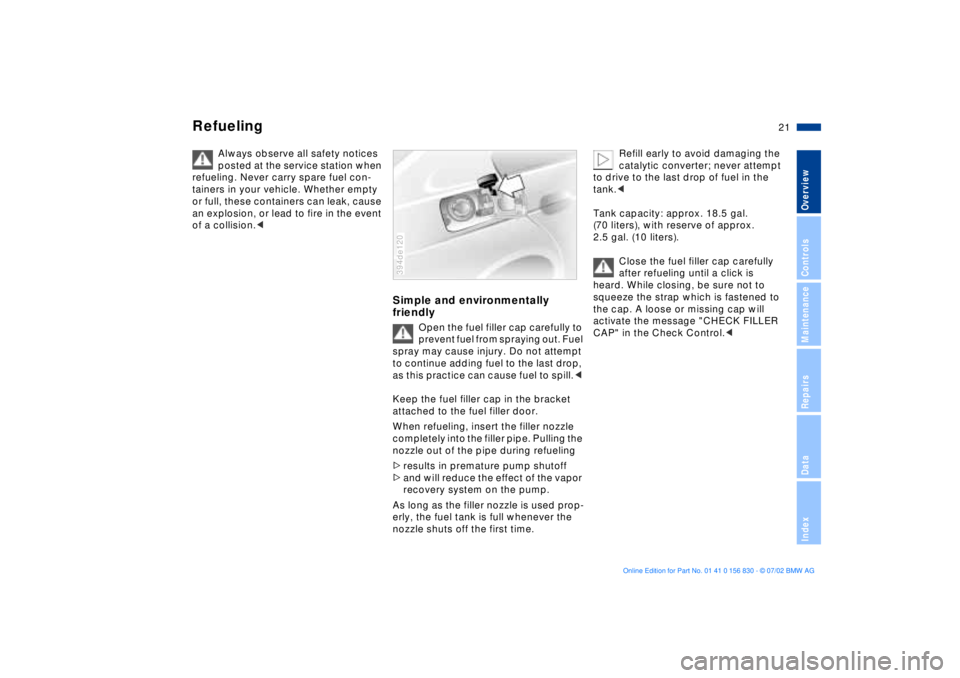
21n
OverviewControlsMaintenanceRepairsDataIndex
Refueling
Always observe all safety notices
posted at the service station when
refueling. Never carry spare fuel con-
tainers in your vehicle. Whether empty
or full, these containers can leak, cause
an explosion, or lead to fire in the event
of a collision.<
Simple and environmentally
friendly
Open the fuel filler cap carefully to
prevent fuel from spraying out. Fuel
spray may cause injury. Do not attempt
to continue adding fuel to the last drop,
as this practice can cause fuel to spill.<
Keep the fuel filler cap in the bracket
attached to the fuel filler door.
When refueling, insert the filler nozzle
completely into the filler pipe. Pulling the
nozzle out of the pipe during refueling
>results in premature pump shutoff
>and will reduce the effect of the vapor
recovery system on the pump.
As long as the filler nozzle is used prop-
erly, the fuel tank is full whenever the
nozzle shuts off the first time.
394de120
Refill early to avoid damaging the
catalytic converter; never attempt
to drive to the last drop of fuel in the
tank.<
Tank capacity: approx. 18.5 gal.
(70 liters), with reserve of approx.
2.5 gal. (10 liters).
Close the fuel filler cap carefully
after refueling until a click is
heard. While closing, be sure not to
squeeze the strap which is fastened to
the cap. A loose or missing cap will
activate the message "CHECK FILLER
CAP" in the Check Control.<
Page 22 of 155
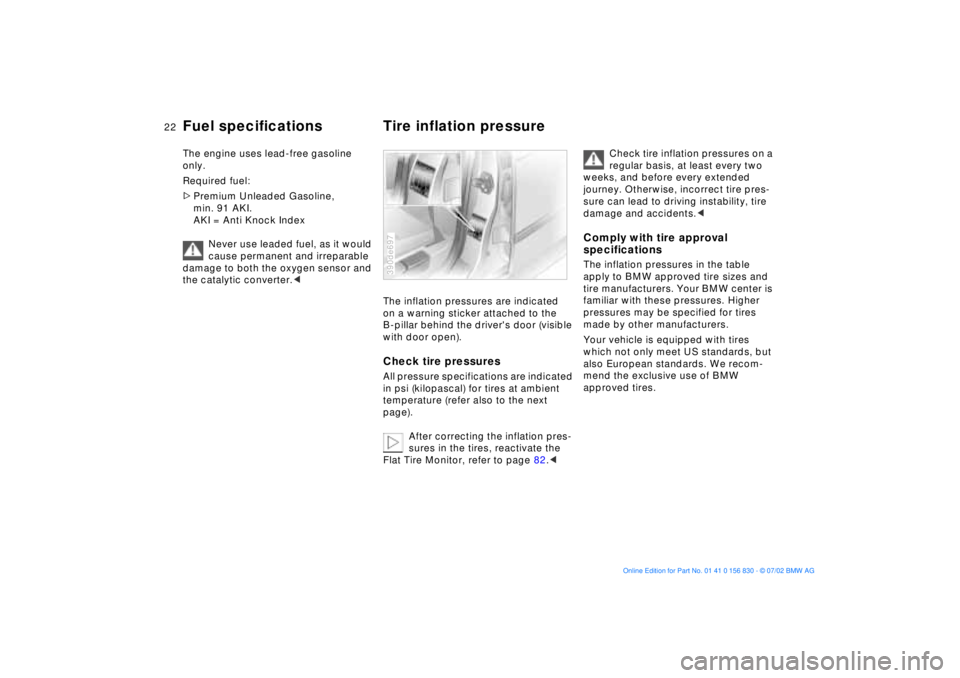
22n
Fuel specifications Tire inflation pressureThe engine uses lead-free gasoline
only.
Required fuel:
>Premium Unleaded Gasoline,
min. 91 AKI.
AKI = Anti Knock Index
Never use leaded fuel, as it would
cause permanent and irreparable
damage to both the oxygen sensor and
the catalytic converter.<
The inflation pressures are indicated
on a warning sticker attached to the
B-pillar behind the driver's door (visible
with door open).Check tire pressuresAll pressure specifications are indicated
in psi (kilopascal) for tires at ambient
temperature (refer also to the next
page).
After correcting the inflation pres-
sures in the tires, reactivate the
Flat Tire Monitor, refer to page 82.<390de697
Check tire inflation pressures on a
regular basis, at least every two
weeks, and before every extended
journey. Otherwise, incorrect tire pres-
sure can lead to driving instability, tire
damage and accidents.<
Comply with tire approval
specificationsThe inflation pressures in the table
apply to BMW approved tire sizes and
tire manufacturers. Your BMW center is
familiar with these pressures. Higher
pressures may be specified for tires
made by other manufacturers.
Your vehicle is equipped with tires
which not only meet US standards, but
also European standards. We recom-
mend the exclusive use of BMW
approved tires.
Page 23 of 155
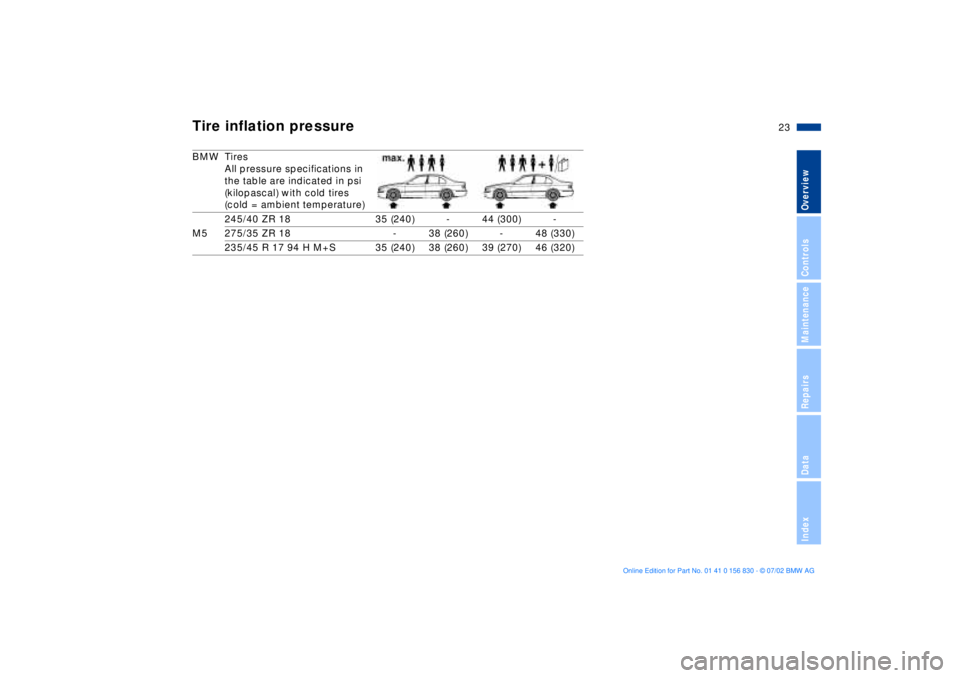
23n
OverviewControlsMaintenanceRepairsDataIndex
Tire inflation pressureBMW Tires
All pressure specifications in
the table are indicated in psi
(kilopascal) with cold tires
(cold = ambient temperature)
M5245/40 ZR 18 35 (240) - 44 (300) -
275/35 ZR 18 - 38 (260) - 48 (330)
235/45 R 17 94 H M+S 35 (240) 38 (260) 39 (270) 46 (320)
Page 24 of 155
24n
Controls
Page 25 of 155
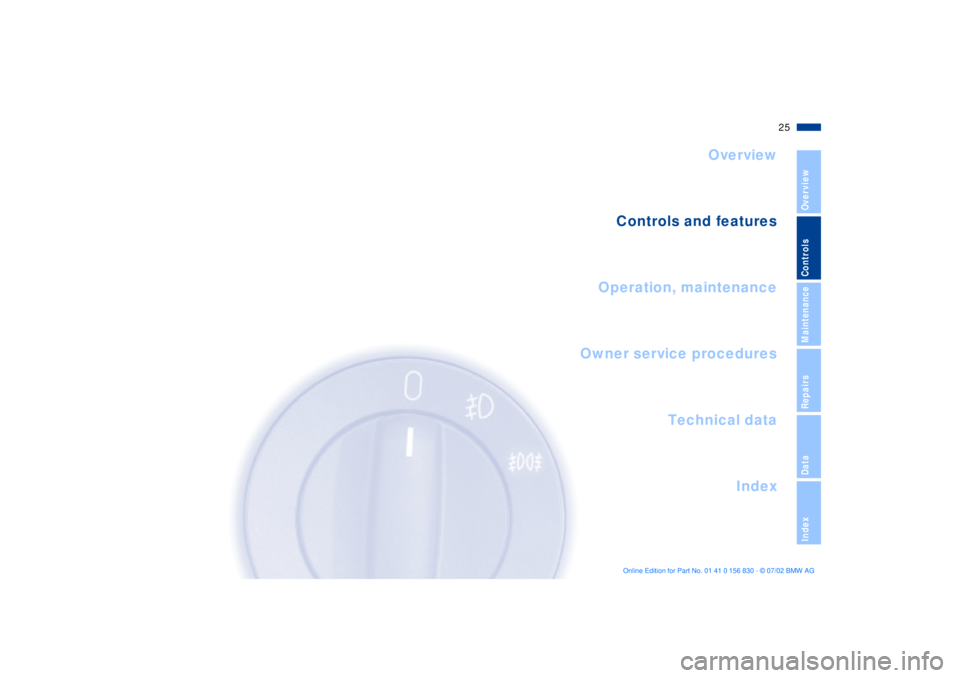
25n
OverviewControlsMaintenanceRepairsDataIndex
Overview
Controls and features
Operation, maintenance
Owner service procedures
Index Technical data
Page 26 of 155
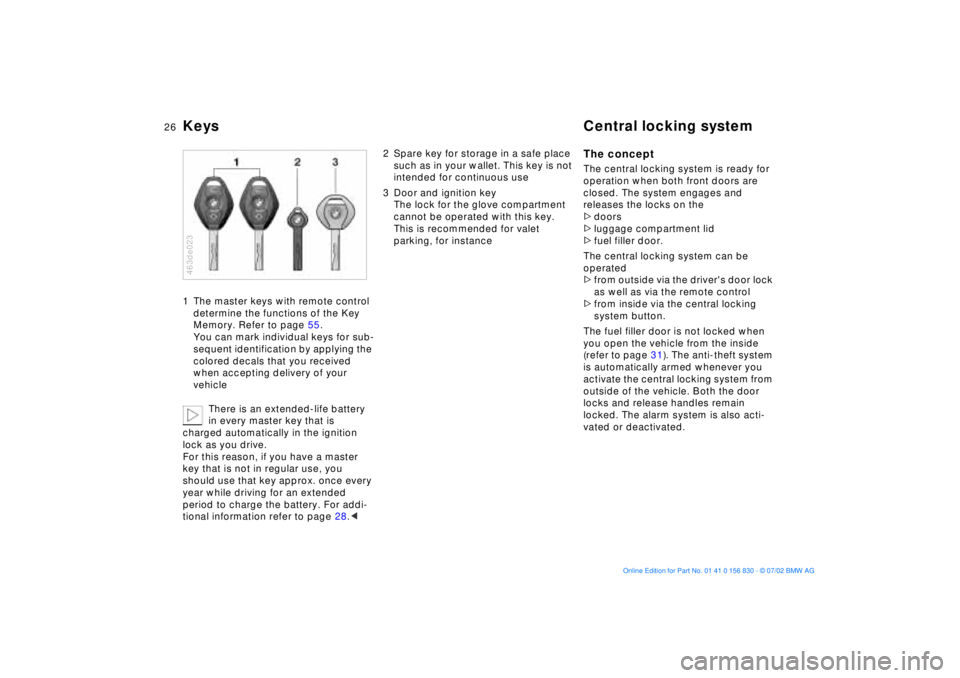
26n
Keys Central locking system1 The master keys with remote control
determine the functions of the Key
Memory. Refer to page 55.
You can mark individual keys for sub-
sequent identification by applying the
colored decals that you received
when accepting delivery of your
vehicle
There is an extended-life battery
in every master key that is
charged automatically in the ignition
lock as you drive.
For this reason, if you have a master
key that is not in regular use, you
should use that key approx. once every
year while driving for an extended
period to charge the battery. For addi-
tional information refer to page 28.< 463de023
2 Spare key for storage in a safe place
such as in your wallet. This key is not
intended for continuous use
3 Door and ignition key
The lock for the glove compartment
cannot be operated with this key.
This is recommended for valet
parking, for instance
The conceptThe central locking system is ready for
operation when both front doors are
closed. The system engages and
releases the locks on the
>doors
>luggage compartment lid
>fuel filler door.
The central locking system can be
operated
>from outside via the driver's door lock
as well as via the remote control
>from inside via the central locking
system button.
The fuel filler door is not locked when
you open the vehicle from the inside
(refer to page 31). The anti-theft system
is automatically armed whenever you
activate the central locking system from
outside of the vehicle. Both the door
locks and release handles remain
locked. The alarm system is also acti-
vated or deactivated.
Page 27 of 155
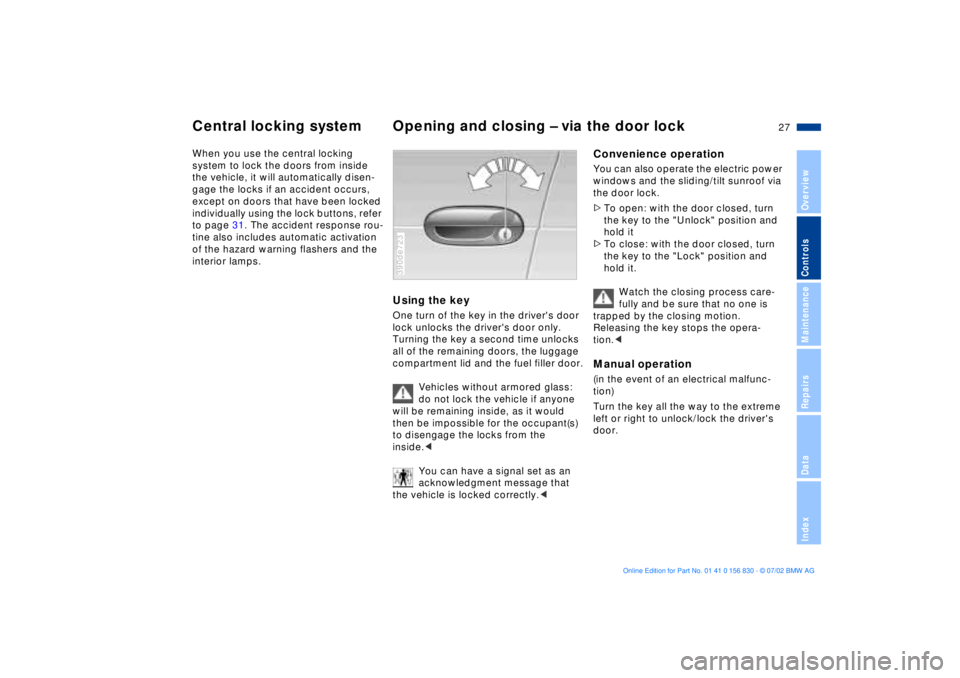
27n
OverviewControlsMaintenanceRepairsDataIndex
Central locking system Opening and closing Ð via the door lockWhen you use the central locking
system to lock the doors from inside
the vehicle, it will automatically disen-
gage the locks if an accident occurs,
except on doors that have been locked
individually using the lock buttons, refer
to page 31. The accident response rou-
tine also includes automatic activation
of the hazard warning flashers and the
interior lamps.
Using the key One turn of the key in the driver's door
lock unlocks the driver's door only.
Turning the key a second time unlocks
all of the remaining doors, the luggage
compartment lid and the fuel filler door.
Vehicles without armored glass:
do not lock the vehicle if anyone
will be remaining inside, as it would
then be impossible for the occupant(s)
to disengage the locks from the
inside.<
You can have a signal set as an
acknowledgment message that
the vehicle is locked correctly.<390de723
Convenience operationYou can also operate the electric power
windows and the sliding/tilt sunroof via
the door lock.
>To open: with the door closed, turn
the key to the "Unlock" position and
hold it
>To close: with the door closed, turn
the key to the "Lock" position and
hold it.
Watch the closing process care-
fully and be sure that no one is
trapped by the closing motion.
Releasing the key stops the opera-
tion.< Manual operation (in the event of an electrical malfunc-
tion)
Turn the key all the way to the extreme
left or right to unlock/lock the driver's
door.
Page 28 of 155
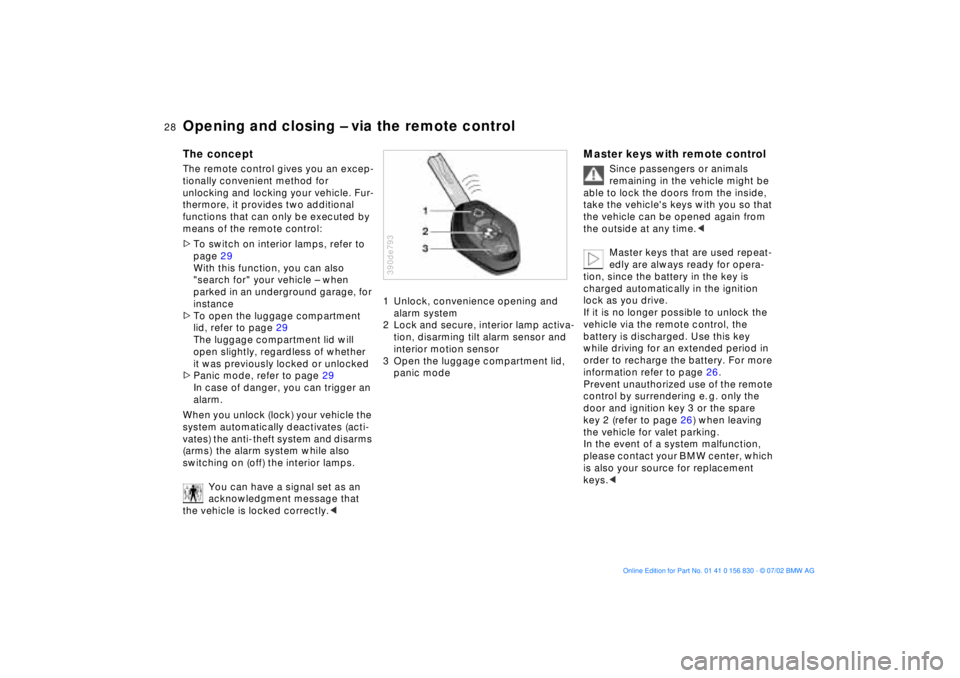
28n
Opening and closing Ð via the remote control
The concept
The remote control gives you an excep-
tionally convenient method for
unlocking and locking your vehicle. Fur-
thermore, it provides two additional
functions that can only be executed by
means of the remote control:
>
To switch on interior lamps, refer to
page 29
With this function, you can also
"search for" your vehicle Ð when
parked in an underground garage, for
instance
>
To open the luggage compartment
lid, refer to page 29
The luggage compartment lid will
open slightly, regardless of whether
it was previously locked or unlocked
>
Panic mode, refer to page 29
In case of danger, you can trigger an
alarm.
When you unlock (lock) your vehicle the
system automatically deactivates (acti-
vates) the anti-theft system and disarms
(arms)
the alarm system while also
switching on (off) the interior lamps.
You can have a signal set as an
acknowledgment message that
the vehicle is locked correctly.
<
1 Unlock, convenience opening and
alarm system
2 Lock and secure, interior lamp activa-
tion, disarming tilt alarm sensor and
interior motion sensor
3 Open the luggage compartment lid,
panic mode390de793
Master keys with remote control
Since passengers or animals
remaining in the vehicle might be
able to lock the doors from the inside,
take the vehicle's keys with you so that
the vehicle can be opened again from
the outside at any time.
<
Master keys that are used repeat-
edly are always ready for opera-
tion, since the battery in the key is
charged automatically in the ignition
lock as you drive.
If it is no longer possible to unlock the
vehicle via the remote control, the
battery is discharged. Use this key
while driving for an extended period in
order to recharge the battery. For more
information refer to page 26.
Prevent unauthorized use of the remote
control by surrendering e. g. only the
door and ignition key 3 or the spare
key 2 (refer to page 26) when leaving
the vehicle for valet parking.
In the event of a system malfunction,
please contact your BMW center, which
is also your source for replacement
keys.
<
Page 29 of 155
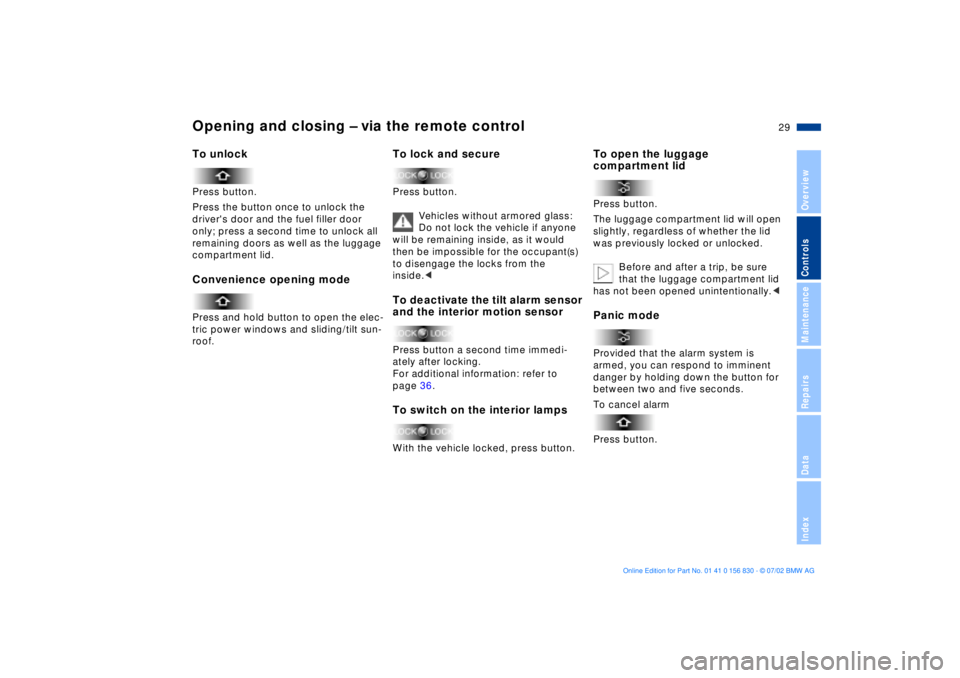
29n
OverviewControlsMaintenanceRepairsDataIndex
Opening and closing Ð via the remote control To unlockPress button.
Press the button once to unlock the
driver's door and the fuel filler door
only; press a second time to unlock all
remaining doors as well as the luggage
compartment lid.Convenience opening modePress and hold button to open the elec-
tric power windows and sliding/tilt sun-
roof.
To lock and secure Press button.
Vehicles without armored glass:
Do not lock the vehicle if anyone
will be remaining inside, as it would
then be impossible for the occupant(s)
to disengage the locks from the
inside.< To deactivate the tilt alarm sensor
and the interior motion sensorPress button a second time immedi-
ately after locking.
For additional information: refer to
page 36.To switch on the interior lampsWith the vehicle locked, press button.
To open the luggage
compartment lidPress button.
The luggage compartment lid will open
slightly, regardless of whether the lid
was previously locked or unlocked.
Before and after a trip, be sure
that the luggage compartment lid
has not been opened unintentionally.
danger by holding down the button for
between two and five seconds.
To cancel alarm
Press button.
Page 30 of 155

30n
For US owners onlyThe transmitter and receiver units
comply with part 15 of the FCC (Federal
Communications Commission) regula-
tions. Operation is governed by the
following:
FCC ID: LX8EWS
LX8FZVS
LX8FZVE
Compliance statement:
This device complies with part 15 of the
FCC Rules. Operation is subject to the
following two conditions:
>This device may not cause harmful
interference, and
>this device must accept any interfer-
ence received, including interference
that may cause undesired operation.
Any unauthorized modifications
to these devices could void the
user's authority to operate the equip-
ment.<
Opening and closing Ð via the remote controlExternal systemsExternal systems or devices may cause
local interference in the functions of the
remote control.
If this should occur, you can unlock and
lock the vehicle via the door lock with a
master key.